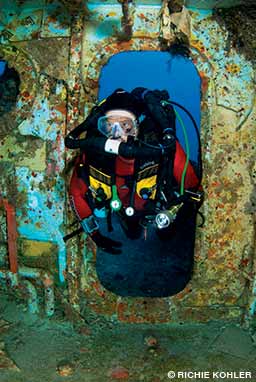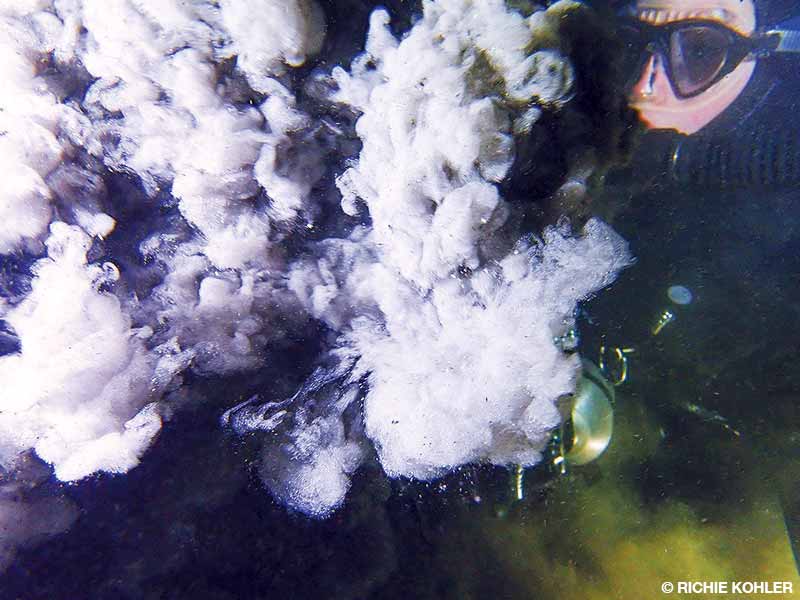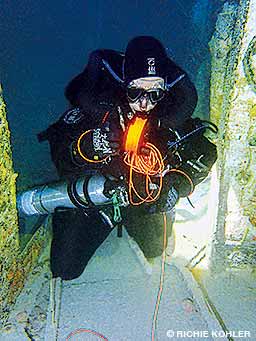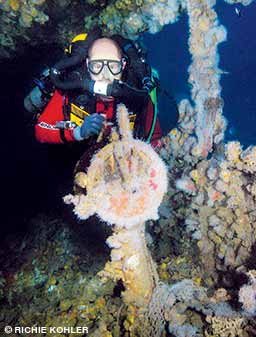Shipwrecks lure divers as much as they attract the sea life surrounding them. A haven for spawning and small fish, they are both nursery and feeding grounds for all types of underwater creatures. In temperate waters, layers of soft and hard corals cover wrecks, providing a mantle of marine growth that alters their features over time until nearly indistinguishable. The spectacle of life on a wreck, an ecosystem unto itself, is often the main attraction for divers.
Whether the ship foundered in a storm or was purposefully sunk as an artificial reef, a shipwreck materializing as you descend is a fascinating sight. There is something inherently spooky and exhilarating about a human-made structure that nature has taken over, and it’s one-stop shopping for both adventure and photo opportunities.

No two shipwrecks are the same. Knowing the wreck’s history lends perspective to the drama, and often tragedy, behind the loss. Not all shipwrecks are in warm water teeming with fish. In the U.S. Great Lakes, wooden sailing ships are still incredibly intact after decades underwater. The cold, fresh water has preserved them, and with little or no marine growth, many look the same as the day they sank.
Nearly every ocean, sea and lake holds a world of shipwreck exploration for advanced open-water divers. Each lost ship, submarine, airplane and even the odd locomotive is a time capsule waiting for an underwater explorer to visit and photograph. As tempting as it may be, never venture inside a shipwreck until you have advanced wreck-dive training from a certified, qualified dive training professional. This additional training as well as requisite equipment are necessary if you want to explore inside a wreck. Once inside, the risks multiply exponentially. Trained wreck divers use specialized equipment and well-practiced techniques to mitigate the dangers and safely explore the sometimes dark and often silt-filled compartments.
The following are a few hazards of wreck diving and penetration.
Overhead Environment
The darkened corridors and hatches on a ship can be very inviting. What lies around that next dark corner? Like a cave or ice dive, however, you can no longer ascend directly to the surface once you enter a wreck. Even with a ship’s multiple entry or exit points, swimming into an overhead environment requires specialized equipment and training to safely make the dive.
Before beginning the dive, you must calculate your air consumption at depth, taking tank pressure and volume into account. An alternate air source, such as a pony bottle or double tanks, with an extra-long hose on your regulator is necessary for shipwreck explorers. In the tight confines of a passageway, traditional buddy breathing or air-sharing methods may not be possible. A wreck-penetration certification class will specifically prepare and train you for an out-of-air emergency exit.
Proper dive planning includes having more than enough air for the dive team to exit the wreck, ascend, make a safety stop or complete any obligatory decompression and then return to the surface with air to spare.
Lost or Disoriented
Wrecks can rest on the seafloor on their sides, completely upside-down and at every possible angle in between. Navigating inside a wreck with the floor, walls and doorways at crazy angles can be disorienting.
A shipwreck will deteriorate over time, compromising its integrity and potentially making navigation even more challenging. Equipment and the interior walls can break loose, blocking passageways or entire compartments. Doors might be rusted shut or stuck halfway open, limiting a diver’s ability to get through.
It can be easy to unknowingly change deck levels or get turned around and not remember the way out. Using a wreck reel provides a clear path out of the wreck. Some shipwrecks are indistinguishable pieces of wreckage randomly strewn about the seafloor. In limited visibility or on a vast site, proper deployment of a wreck reel can get you back to your starting point or anchor line.
Silt Out
Deep inside a wreck, there is often no ambient light and very little water flow. In these conditions, fine, dustlike silt lines the floor and builds up on all surfaces. Safe navigation inside a shipwreck requires a strong primary light, backup lights and a large primary wreck reel. Divers can use special swimming and finning techniques and maintain excellent buoyancy control to help prevent churning the silt.

In the tight confines of a silt-filled wreck, a diver’s exhaust bubbles hitting the ceiling can disturb the visibility. Even when divers use good techniques, dive lights can fail, or accidental missteps can happen. A properly laid line from your wreck reel is your direct path to getting out safely in any of these situations.
Entanglement

Wrecks are often favorite fishing spots, and fishing line may be caught on the exterior or even inside a wreck. Monofilament fishing line can be almost impossible to see in certain conditions. Fishing nets might be caught on the structure of older shipwrecks. Although nets are usually easy to see and avoid, they can still be a hazard if you’re not paying attention.
As a wreck rusts and deteriorates, pipes, cables and wires once hidden in ceilings and walls can come loose and snare divers’ equipment. Divers or their bubbles might accidentally dislodge objects, disturbing the visibility or even trapping them inside the wreck. Proper training helps you to recognize entrapment hazards and teaches you how to remove a snag on your equipment or safely use a cutting device without panicking. Training and experience using a wreck reel will help protect you from another significant entanglement hazard: your own line.
Environmental Hazards

As steel wrecks rust away, broken, sharp edges can form. Divers may also encounter sharp encrustation, such as barnacles or oysters, or irritants such as fire coral. Gloves and exposure suits combined with good form to avoid touching the wreck will help prevent cuts and abrasions. Even in warm waters where thermal consideration isn’t necessary, a dive skin or 3 mm wetsuit can protect divers from scrapes and cuts caused by inadvertently bumping the wreck. It’s always a good idea to have a properly equipped first aid kit.
Crews clean and prep artificial reefs or purposely placed shipwrecks before sinking them, removing loose objects and creating many extra access points into the ship. They remove any oil, gasoline or other dangerous lubricants and clean the vessel to prevent damage to the environment and visiting divers. Accidental wrecks can still be carrying fuel or lubrication oils. The remains of dangerous chemicals, including solvents and lead-based paints, could be hidden in the silt and mud of a wreck. Sunken warships and wartime cargo vessels may still have the remains of unexploded ordnance. All of these items generally are not a danger to divers unless disturbed. Divers should also be careful not to disturb sailors’ remains, which are considered war graves.
Dangerous Marine Life
As a shipwreck explorer for more than 40 years, I often get asked about “dangerous” sea creatures. People want to know about sharks, which I always enjoy seeing on a dive and have never caused me any problems. The most hazardous marine life encounters I have had are the sharp edges of oyster shells I always seem to clumsily bump against, the sting of a jellyfish that drifted against my face (my fault for not looking) and the pinch of an irate lobster that I tried to grab for dinner.
Although the hazards discussed are very real and potentially dangerous, divers with the proper training, equipment and planning can safely explore shipwrecks. It’s an opportunity for underwater explorers to go on an incredible adventure and dive into history.
© Alert Diver — Q2 2021